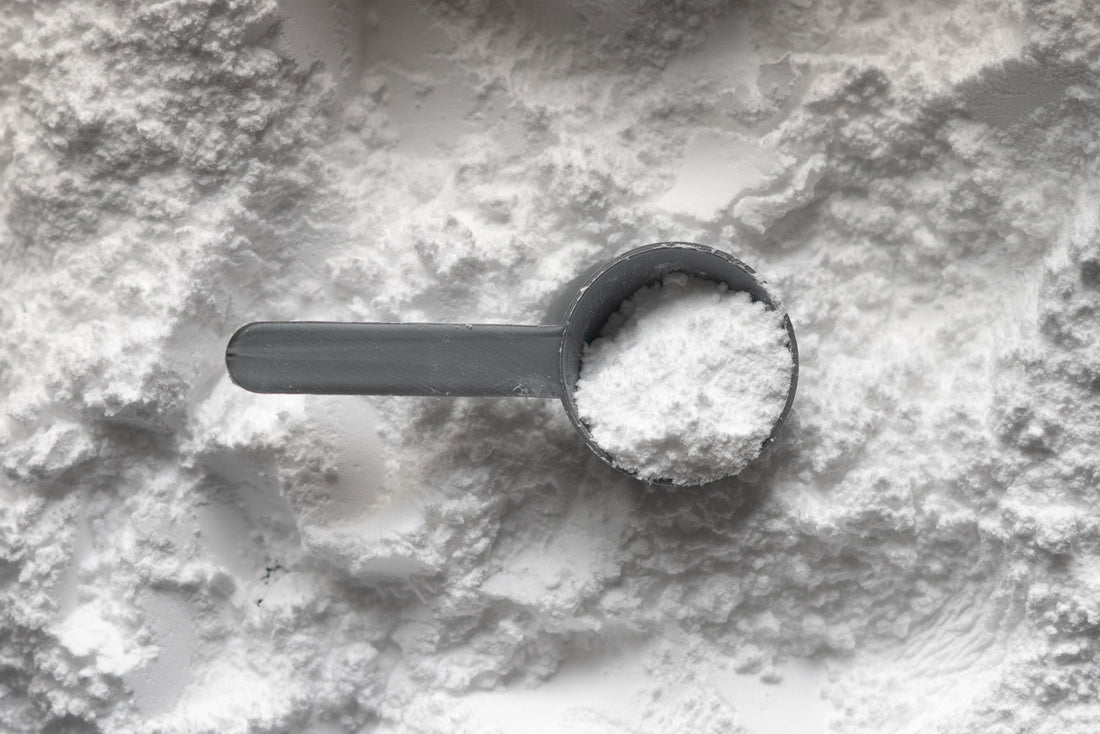Beginners Guide To Creatine

Creatine is one of the most popular sports nutrition products, designed to help improve athletic performance. Creatine has been shown to increase muscular size and muscular endurance, but it's also important to know what creatine is and how to use it properly.
Here, we'll be examining the pros and cons of creatine and how to use it properly.
What Is Creatine?
Made from three amino acids (L-arginine, Glycine & L-methionine) creatine is an organic compound produced by the liver that supplies energy throughout the body, especially to muscles. It helps maintain muscle strength and increases the rate at which your muscles can contract. This allows you to work out for longer and lift heavier weights for more extended periods of time, without damaging your muscles.
Not only can creatine be naturally produced by the human body, but we can also consume creatine through our diets. Creatine is most commonly found in milk, red meats & fish.
What is Micronized Creatine?
Micronized Creatines are essentially creatine monohydrates, but they've been broken down into smaller pieces. This increases its surface area by 20x, which increases its absorptivity and reduces stomach distress.
How Does Creatine Work?

Creatine works by increasing the amount of ATP available within a cell. When you exercise, your cells release lactic acid into your bloodstream. The lactic acid binds with the creatine molecules present in your bloodstream, creating a chemical reaction that releases additional ATP. This process is called phosphorylation. Phosphorylation occurs when your body uses creatine as fuel during intense physical activity.
Why Should I Take Creatine?
There are many benefits associated with taking creatine supplements. These include:
- Increased Muscle Size
- Increases in Strength
- Improved Endurance
- Increased Power Output
- Enhanced Recovery Time After Exercise
The first benefit of creatine supplementation is increased muscle mass. By consuming creatine, you're able to store more glycogen in your muscles, allowing them to grow larger than they would otherwise.
The second benefit of creatine is improved strength. As mentioned above, creatine increases the amount of ATP available to your muscles, allowing you to perform exercises for longer and harder.
The third benefit of creatine is enhanced endurance. With creatine, you can train longer and harder, because your muscles have the ability to produce more ATP.
Finally, creatine improves recovery time after exercise. This means that you will recover faster from workouts, allowing you to get back on the field or gym sooner.
Creatine & Exercise Performance
When used correctly, creatine can significantly enhance your workout experience. However, there are some things you need to consider before using creatine. Here are some tips to keep in mind:
Consume Creatine Before or After Your Workout
If you want to maximize the effects of creatine, you should take it before your workout begins. This way, your muscles will absorb the creatine more quickly, allowing it to enter your system more efficiently.
You can also take creatine post-workout as a quick way of restoring muscle strength and improving recovery.
Take Creatine During Low-Intensity Exercises
You don't necessarily need to take creatine if you're doing low-intensity exercises like walking or jogging. You still get plenty of benefits from these types of activities, so you shouldn't feel the need to supplement with creatine.
However, if you're performing high-intensity exercises like sprinting or weightlifting, then you'll definitely want to take creatine. If you do decide to use creatine during these types of exercises.
How Much Creatine Should I Take?

If you're new to creatine, it's important to begin in what's known as the 'Creatine Loading Phase'.
During the initial stage of creatine supplementation, you want to load up on creatine by taking large doses for several days, this is known as the loading phase and is designed to front-load your creatine levels and get creatine delivered to the muscles quicker than usual.
It is suggested that 20 grams of creatine per day are optimal for the loading phase, and this lasts for up to 7 days.
Once you've finished with the initial stages of creatine monohydrate, then it's time to move to the maintenance stage of muscle creatine levels. Which is a less intense period of regularly including up to 5g of creatine per day. This can be done with an improved diet, however, is mostly achieved through the use of creatine powder or creatine supplements.
How To Take Creatine Monohydrate?
Increasing your levels of creatine can be achieved through creatine powder or creatine capsules. For best results, it has been suggested that pairing your daily dosage of creatine followed by a high-carb nutritional meal can increase the time it takes for your body to absorb the creatine, and deliver it to the muscles.
There are two main forms of creatine, powdered, or capsules - both have their own advantages and disadvantages, and it is likely down to the individual as to which one suits them best, but let's take a look at both.
Creatine Powder
Much like your standard protein powders and other powdered supplements, creatine powder can be mixed in with your protein shake, or simply added to water to be consumed pre or post-workout, and alongside your daily meal plans.
The Benefits of Powdered Creatine
- Affordable - Arguably the biggest benefit of powdered creatine is the affordability, unlike pills, creatine powder can be bought in bulk and can last far longer, meaning your supplement supplies are less likely to need regular restocking, saving you money in the long run.
- Easier to manage dosages - Unlike tablets, creatine powder is able to be measured and weighed by the individual, whereas pills are pre-measured dosage amounts that are unable to be personalised for individual uses. This means powdered creatine is far more useful during the initial loading stages of supplementation with creatine.
- Creativity - With powdered grams of creatine you are able to create your own shakes, drinks & smoothies that can shake your diet up and keep you enjoying your favourite dietary supplements.
The Cons of Powdered Creatine
- Transportability - If you're an avid gym visitor, then you understand the annoyance of transporting large tubs of powdered protein or supplements to and from the gym.
- Messes - Whilst having powdered creatine is beneficial when measuring individual dosages, it can become messy, it can also become difficult to fully mix with water or whey proteins, getting stuck in your shaker is arguably one of the most annoying issues when it comes to powdered dietary supplements.
Creatine Pills

Whilst the effects of creatine supplementation are the same whether you choose to use powder or pills there are key differences in usability.
The Pros of Oral Creatine Supplements (Pills)
- Convenience - Hands down, creatine pills are far easier to transport than a large tub of powdered diet supplements, making them far more convenient than carrying around a large tub of powder, or worrying about not having any drink to mix your nutritional supplements with.
- Accurate dosages - Adjusting your body to the 'maintenance stage' is far easier with pills, this is because your dosage will always be to the exact amount, and you won't have to worry about weighing or scooping your creatine.
The Cons of Creatine Supplementation Pills
- Absorption time - Unfortunately, unlike powdered protein & creatine, the absorption time with pills is far slower than powder, meaning there is no immediate effect when taking tablets or pills compared to powder which will deliver the creatine to the muscle cell immediately.
- Cost - Unfortunately, with convenience, comes a cost, whilst both powder and pills help improve physical performance, due to more durable packaging, and ease of use the creatine pills are roughly 2 X more expensive than scooping your own creatine grams per day.
What To Take Creatine With?
When choosing between powders and pills, it's important to remember that they work differently, so what works best for one may not work as well for another.
With creatine powders, you want to make sure you take them on an empty stomach, as this allows the creatine to enter the bloodstream faster and reach the muscles quicker.
Taking powdered creatine can be mixed with either water or juice. However, you can also add to your daily protein shake or meal replacement shake
.
The Best Time To Take Creatine

There have been a few studies into the effects of when creatine consumption is at its most optimal, with several researchers suggesting that taking creatine after exercise led to greater gains in muscle strength.
However, whilst there is no conclusive evidence that suggests taking creatine post-workout is superior to taking it pre-workout, there are a handful of relevant studies that suggest taking creatine around the time of exercise (before or after) offers greater muscle growth than taking it at random points during the day.
How Long Does Creatine Take To Work?
Creatine takes about 2 hours to work, which means that you need to consume it at least two hours before exercising, in order to feel the effect pre-workout. However, post-workout your body is more focused on repairing the muscle and is believed to be more fast-acting.
Should I Take Creatine every day?
You can take creatine every day, however, it is important to give your body a 'rest day'. Creatine muscle stores can last even if the body is having a rest period. There is some research that indicates overuse of creatine may have an effect on kidney function, however, there is not enough research to support the notion that creatine has adverse effects on the kidneys.
List of Foods That Naturally Include Creatine

| Food Type | Creatine (grams per 100g) |
| Beef | 0.9g |
| Herring | 0.9g |
| Salmon | 0.9g |
| Pork | 0.7g |
| Ham | 0.6g |
| Lamb | 0.5g |
| Chicken | 0.4g |
| Tuna | 0.4g |
| Cod | 0.3g |
| Sausage | 0.2g |
| Bacon | 0.2g |
| Milk | 0.02g |
The Side Effects of Creatine
As mentioned earlier, creatine has been used for decades as a supplement to increase athletic performance, however, like many other supplements, creatine does come with some side effects.
Side Effects Of Creatine
- Increased heart rate - The increased heart rate caused by creatine may cause anxiety or stress in people who suffer from high blood pressure.
- Muscle cramps - Muscle cramping is a common side effect of creatine supplementation, especially if you take too much.
- Muscle soreness - Taking creatine before working out can lead to muscle soreness, particularly if you're new to creatine supplementation.
- Irritated Skin - In some cases, creatine users have reported itchiness & redness, however, this is a less common symptom.
- Weight Gain - Although creatine helps build muscles, it also causes weight gain.
- Stomach upset - Some people report stomach upsets when they first start using creatine, but these symptoms usually go away within a couple of weeks.
What happens if you stop taking creatine
If you decide to discontinue creatine use, you should do so gradually. You should reduce your dosage by 25% each week until you reach zero.
This gradual reduction in dosage will allow your body to adjust to the lack of creatine without experiencing any negative effects.
It's recommended that you continue to eat a healthy diet, drink plenty of water, and get regular exercise.
If you do stop creatine altogether without a cool-down period, you may experience mild side effects such as:
- Fatigue
- Muscle weakness
- Weight-loss



